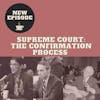Supreme Court: The Confirmation Process

In recent years, much has been written about the political theater involved in Supreme Court Justice confirmation hearings. Many Americans report feeling frustrated at both the question asked by Senators and the answers provided by future associate justices.
One long time listener asked that I review the history of supreme justice nominations and the confirmation process. Has it always been so polarizing and political? Have justices always avoided answering questions?
SOURCES
Armstrong, Scott., Woodward, Bob. The Brethren: Inside the Supreme Court. United States: Simon & Schuster, 2011.
Collins, Paul M. & Lori A. Ringhand. “The Institutionalization of Supreme Court Confirmation Hearings.” Law & Social Inquiry, Vol 41, Issue 1, 126-151. Winter 2016.
Dean, John W.. The Rehnquist Choice: The Untold Story of the Nixon Appointment That Redefined the Supreme Court. United Kingdom: Free Press, 2002.
Glass, Andrew. “Wilson nominates Brandeis to Supreme Court, January 28, 1916.” Politico. January 28, 2019. (LINK)
Hall, Kermit L.. The Oxford Companion to the Supreme Court of the United States. United Kingdom: Oxford University Press, 1992.
“Nixon Dropped California Appeals Court Justice Mildred L. Lillie.” The President Calling. American Public Media. (LINK)
Raz, Guy. “A History of Supreme Court Confirmation Hearings.” All Things Considered. National Public Radio. July 12, 2009. (LINK)
Ringhand, Lori & Paul Collins. “Legal Scholarship Highlight: The Evolution of Supreme Court Confirmation Hearings.” SCOTUSBlog. March 25, 2016. (LINK)
“Supreme Court Nominations: 1789 - Present.” United States Senate. (LINK)
United States Constitution. (LINK)
“He shall have Power, by and with the Advice and Consent of the Senate, to make Treaties, provided two thirds of the Senators present concur; and he shall nominate, and by and with the Advice and Consent of the Senate, shall appoint Ambassadors, other public Ministers and Consuls, Judges of the supreme Court, and all other Officers of the United States, whose Appointments are not herein otherwise provided for, and which shall be established by Law: but the Congress may by Law vest the Appointment of such inferior Officers, as they think proper, in the President alone, in the Courts of Law, or in the Heads of Departments.” United States Constitution, 1787.
Welcome to Civics and Coffee. My name is Alycia and I am a self-professed history nerd. Each week, I am going to chat about a topic on U.S history and give you both the highlights and occasionally break down some of the complexities in history; and share stories you may not remember learning in high school. All in the time it takes to enjoy a cup of coffee.
INTRO MUSIC
Hey everyone, welcome back.
The Supreme Court is the preeminent judicial body in the United States. The last stop to determine whether something is constitutional, the Supreme Court has heard cases covering all aspects of our lives. The court has decided cases impacting everything from land use to segregation, and the death penalty. Its power dates back to the landmark case, 1803’s Marbury versus Madison, which established the court’s authority for judicial review. Since then, the court has wielded this authority to make significant changes to the country.
If you’ve had even a passing interest in news and politics in the last few years, then you’re likely aware of the contentious and often highly political battles over Supreme Court nominees. Many of you may have asked yourselves, was it always this way? And at least one of you sent in a request.
Long-time listener Jennifer asked that I cover the history of Supreme Court Justice nominations. How does the process work? How has it evolved? And what do these nominations tell us about our history?
Grab your cup of coffee, peeps. Let’s do this.
As I covered in a previous episode, the Constitution laid the groundwork for the Supreme Court in 1787. If you want to learn more about the history of the court including how it established its authority, I recommend checking out the episode titled Marbury v Madison, which is number 64 in the catalog.
In that episode, I covered how the aforementioned legal challenge over a presidential appointment secured the jurisdiction and influence the court wields today. Several journalists and historians have reviewed the influence of the Supreme Court throughout history and analyzed various individual justices' contributions to the court. There are numerous books and documentaries investigating individual nominations and confirmation hearings. However, I was unable to find a book on the appointment process overall and how it evolved since the court's creation.
This may be because, for the majority of the court's existence, the nominating and confirmation process of a Supreme Court Justice was a relatively routine affair. Nominations and confirmations were typically uneventful with only a few instances drawing controversy. Given the increasingly polarized nature of politics in the last few decades, I think future historians will have much to say about recent nominations and how their appointments reflected the country
As I read in the introduction to the episode, article two, section two of the United States Constitution permits the president to nominate a justice to the court, which then goes through consent - or confirmation - with the Senate. Anyone who's watched a supreme court nomination over the past thirty years is likely familiar with how much media attention these hearings receive and may have wondered, was it always like this? Well, the short answer is no.
Historically speaking, the Senate took a more passive role in its advice and consent mandate. Although the Constitution outlined the process for nominating a judge, it lacked specific information regarding the qualifications and criteria a judge should possess to be eligible for appointment. Before the creation of the judiciary committee in 1816, nominations for judicial appointments were conducted privately. Despite the establishment of the committee, the majority of the nominations were confirmed without any further review or hearings. Between 1816 and 1867, two-thirds of the nominees went through the committee by a simple motion. After 1868, all nominees were referred to the committee for consideration, however, decisions about a candidate's confirmation continued to be discussed privately. When hearings were held, they mostly focused on analyzing documents and taking witness testimony.
Throughout the eighteenth and nineteenth centuries, the Senate confirmed the president’s choices for the court without much fanfare. 146 individuals, mostly men, have been nominated for the court, and 123 of them confirmed. Of those who didn’t make it to the bench, 11 were rejected due to roll call votes, 12 were withdrawn by the president and 14 went without a vote, lapsing at the end of the congressional session. George Washington holds the record as the president with the most appointed justices, with 11 to his credit. Jimmy Carter holds the distinction of being the only president to serve a full term without a Supreme Court appointment. And president William Taft is the only former chief executive to serve as a justice.
Public hearings for judicial nominees really began in the early part of the twentieth century - and initially were only leveraged for nominees who were considered controversial. The first such hearing was over Woodrow Wilson’s choice of Louis Brandeis (BranDICE) in 1916. Brandeis, known for his legal work on social justice and privacy laws, had earned quite a few enemies from big business. Described by historian and lawyer Lucas Powe as the quote “first public interest lawyer” Brandeis had a reputation as the “people’s attorney.” But he was also Jewish. And given the politics of the time, his religion played an unfortunately significant role in the Senate’s concern about this nomination. Thus, the judiciary called a public hearing, the first time the chamber had done so since the country’s inception. For his part, Brandeis elected not to participate in the hearing. The judiciary committee seemed to drag its feet, prompting the Attorney General to suggest the committee ask the president his reasons for selecting Brandeis. Wilson’s response? Quote: “No one is more imbued to the very heart of our American ideals of justice and equality of opportunity” end quote. After four months, Brandeis was confirmed by a vote of 47 to 22.
Just over twenty years later, the committee would hold another hearing, this time to consider the nomination of Felix Frankfurter in 1939. Nominated by President Franklin Roosevelt, Frankfurter was requested to give testimony by the judiciary committee, marking the first time the chamber requested testimony from a future supreme court justice. The call for testimony from the nominee was due to several factors, including the fact that until his nomination, Frankfurter had been an advisor to the president. Another reason for the move towards public accountability was due to the previous confirmation of Hugo Black, a former Senator whose affiliation with the Ku Klux Klan went uninvestigated or discussed during his rapid five-day confirmation process. The public was unhappy with how Black’s nomination was handled, with some feeling he was rushed through given his political connections and to avoid discussing his affiliation with the white supremacist group. The American Bar Association joined the demands for public hearings and it fell to Frankfurter to fill the bill.
Frankfurter did what he was asked and complied with the request to attend the hearing, but refused to answer any questions. He reasoned that his record could speak for itself and he felt it would be quote “inappropriate” end quote to go beyond what was already part of the public record. Despite his stonewalling, Frankfurter was confirmed fairly quickly, just a few weeks after his initial nomination.
By 1955, public hearings were the standard and Potter Stewart was the first nominee to attend a hearing and answer questions from committee members in 1959. Though the word answer should likely be placed in air quotes as the answers provided by Stewart lacked any real substance. Regardless, judiciary members remained committed to calling nominees before the committee to ask them about their judicial philosophies and understanding of the law. In their analysis of the evolution of Supreme Court nominations, political scientist Paul M Collins and law professor Lori A Ringhand assert several factors influenced the decision to make judicial nomination hearings standard. One consideration, and perhaps one of the most significant, was the decision in Brown v Board of Education.
While the court had consistently been political, the decision in Brown put their influence in a new light. Suddenly, the court was a more visible agent, handing down decisions that had immediate and tangible impacts on the lives of Americans. And these decisions were not necessarily popular. Thus, the Senate felt duty-bound to more thoroughly vet potential justices. As Collins and Ringhand write, quote: “The court’s newfound prominence in US political debate likely motivated senators to examine potential members of the court more rigorously, which was furthered by initiating the custom of nominee testimony,” end quote. There was also a political angle to this decision as senators could also use the hearings to become more visible to the American people, a phenomenon enhanced with the advent of televised confirmation hearings, inaugurated by Sandra Day O’Connor’s nomination in 1981.
Confirmation hearings also had political implications for presidents who now had to vet their choices against how the public, or Senate committee members, might react. During his presidency, Nixon considered appointing two women to the court, Mildred Lillie and Sylvia Bacon. Not because he was a champion of women. In fact, transcripts of his conversation discussing their potential nominations and what women should and should not be allowed to do paint the exact opposite picture. But Nixon was an intelligent, politically minded president and knew that putting a woman’s name forward as a potential nominee, especially as women were demanding more equality and assuming a larger public persona, could earn him positive points with voters. Ultimately, Nixon landed on William Rehnquist who would go on to become chief justice in 1986.
But, it seems it was television coverage that had the largest impact on what many Americans find to be a frustrating and unproductive confirmation process. In their same analysis of confirmation hearings, Collins and Ringhand tracked the number of comments offered during the various hearings held to consider a nominee. While they found a steady increase between the 30s and 70s, the number truly skyrocketed in the 80s, following O’Connor’s confirmation. Instead of spending their time investigating a nominee’s judicial background or trying to get a sense of how they might perform on the court, senators spent their time mostly pontificating about their legislative accomplishments or highlighting their committee work.
The surge of comments over questions, combined with the increasingly polarized nature of American politics means the confirmation hearings have amounted to little more than political theater. Despite the significant role the court plays in the lives of americans, nominees can largely avoid answering substantive questions. The growing frustration with the process, combined with some of the more unpopular decisions made by the court in recent years, has many calling for an amendment to the Constitution to institute term limits for Supreme Court Justices. I have read proposals for limits ranging anywhere from 8 to 10 years, all with the argument that this would both decrease some of the political theatrics we witness now as well as ensure the court remained balanced as both sides of the political spectrum would have an opportunity to appoint a justice.
Those opposed to term limits point to the constitution’s assertion that a justice quote “shall hold their offices during good behavior,” end quote. In their opinion, a justice should be able to enjoy a lifetime appointment to the bench and only be recalled for misconduct. This, they claim, is the only way to ensure a judge is a-political and sticks to a strict and truthful interpretation of the constitution. Wherever you land on the term limit question, I think former chief justice Warren Burger had it right when he said quote, “A court which is final and unreviewable needs more careful scrutiny than any other. Unreviewable power is the most likely to self-indulge itself and the least likely to engage in dispassionate self-analysis. In a country like ours, no public institution, or the people who operate it, can be above public debate,” end quote.
Thank you again to Jen for your timely and interesting request. As always, this was a fascinating historical deep dive that only served to add additional topics to my ever-growing list of episodes to get through. If you ever have a topic you want me to cover, do not hesitate to reach out. I am active on Instagram and the bird app - I am still trying to figure out the whole mastodon thing. You can also always reach me through my website at www dot civics and coffee dot com.
And before I sign off today, I want to give a heartfelt thanks to Joann, Jeff, and Dani for their donations to the podcast through Buy Me A Coffee. This is a labor of love and I am always so humbled by the support. Thank you so much.
Thanks, peeps. I’ll see you next week.
Thanks for tuning and I hope you enjoyed this episode of Civics & Coffee. If you want to hear more small snippets from american history, be sure to subscribe wherever you get your podcasts. Thanks for listening and I look forward to our next cup of coffee together.
OUTRO MUSIC
Listener Favorites
Not sure where to begin? Take a listen to some fan favorites.

























